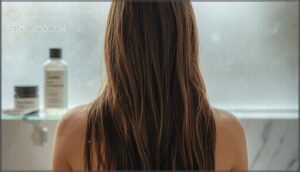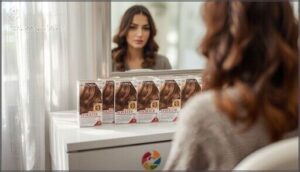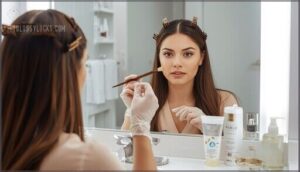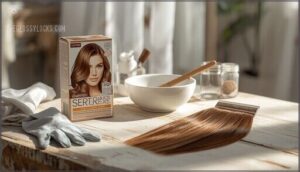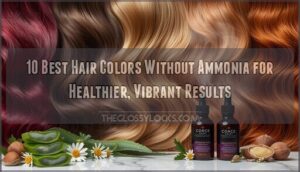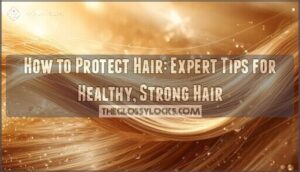This site is supported by our readers. We may earn a commission, at no cost to you, if you purchase through links.
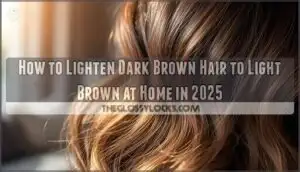 Dark brown hair holds a secret most people discover the hard way: it resists change like a stubborn friend who refuses to leave a party. While platinum transformations flood social media, the jump from dark brown to light brown sits in a tricky middle zone—dramatic enough to demand real technique, subtle enough that one wrong move leaves you brassy orange instead of sun-kissed caramel.
Dark brown hair holds a secret most people discover the hard way: it resists change like a stubborn friend who refuses to leave a party. While platinum transformations flood social media, the jump from dark brown to light brown sits in a tricky middle zone—dramatic enough to demand real technique, subtle enough that one wrong move leaves you brassy orange instead of sun-kissed caramel.
Most home lightening disasters happen because people treat their dark hair like it’s already halfway there, skipping essential prep steps and grabbing whatever box promises “natural-looking highlights.”
The truth? Successfully lightening dark brown hair to light brown requires understanding your hair’s underlying pigments, choosing between gradual or immediate approaches, and knowing which products protect your strands while lifting color—because the difference between glowing dimension and fried regret often comes down to preparation and patience.
Table Of Contents
- Key Takeaways
- How to Lighten Dark Brown Hair to Light Brown
- Lightening Dark Brown Hair With Box Dye
- Lightening Already-Colored Hair at Home With Hair Dye
- Alternative Methods to Lighten Already-Colored Hair
- Maintaining Lightened Dark Brown Hair
- Frequently Asked Questions (FAQs)
- Will lightening my dark brown hair damage it?
- How long does it take to lighten dark brown hair?
- What’s the difference between highlighting and all-over lightening for dark brown hair?
- What’s the best way to lighten my hair if I have highlights already?
- Can I lighten dark brown hair without bleach?
- How long does lightening dark brown hair take?
- Will lightening damage my dark brown hair permanently?
- What level developer should I use for lightening?
- Conclusion
Key Takeaways
- Lightening dark brown hair to light brown requires understanding your hair’s underlying pigments and choosing between gradual methods (like chamomile tea or honey masks over 6-8 weeks) or immediate approaches (bleaching with 20-volume developer), with success hinging on proper preparation rather than rushing the chemical process.
- Already-colored hair presents unique challenges because permanent dye can’t lift artificial pigment—you’ll need bleaching to strip existing color first, which breaks 15-20% of protein bonds and requires 8-10 weeks between sessions to prevent the 52% strength loss that comes from repeated treatments.
- Protection strategies are non-negotiable: sulfate-free shampoos extend color vibrancy by 30-40%, heat protectants cut breakage by 30%, and weekly deep conditioning restores up to 60% of lost moisture, while UV protection prevents the 65% pigment loss that unprotected hair suffers after eight weeks.
- Professional salon lightening delivers results home methods can’t match through custom color formulas (200+ tonal options), controlled developer strengths that cut damage by 30%, and bond-building additives that preserve hair integrity while correcting the 70% of botched DIY jobs colorists regularly fix.
How to Lighten Dark Brown Hair to Light Brown
Lightening dark brown hair to light brown isn’t about gambling with chemicals—it’s about taking charge with the right technique and products. You’ll need to understand your starting point, pick your approach carefully, and protect your hair through the process.
Here’s what you need to know to transform your color safely and successfully.
Choosing The Right Shade
Shade selection isn’t guesswork—it’s about matching light brown hair color shades to your skin undertones for a natural result. Check your wrist veins: green signals warm undertones (think golden or honey brown), blue indicates cool undertones (ash or mushroom brown works best), and both means you’re neutral and can rock most shades.
Undertone analysis prevents that “this doesn’t look right” moment when choosing hair color for dark brown hair. Understanding your skin tone types is essential for making an informed decision.
Gradual Lightening Techniques
Once you’ve nailed the right shade, it’s time to break free from harsh methods and embrace gradual lightening techniques that don’t wreck your hair. Natural lightening with oxidative agents like honey and chamomile works because honey releases trace hydrogen peroxide that lifts pigment 1–2 shades over several weeks.
For sun-activated lightening, apply hydrogen peroxide mixed with chamomile, then sit in direct sunlight for 1–2 hours—visible light decomposes melanin granules faster than UV alone. If you’re lightening dark hair at home, controlled peroxide formulations reduce pigment by 20–30% depending on contact time.
The hair lightening process demands patience: 3–5 weekly applications over four weeks achieves one to two shade lift without the chemical assault of aggressive bleach. To achieve the best results, consider using natural hair methods that promote healthy hair.
Safe Products for Color-Treated Hair
After gradual lightening lays the foundation, protecting your progress demands smart product choices. Sulfate-Free Shampoos like ColorProof Moisture Shampoo prevent color stripping—they maintain vibrancy 40% longer than traditional formulas while keeping your hard-won lift intact. Pair them with pH Balanced Products that hover around 4.0–5.0 to seal the cuticle and lock in 90% of dye retention after ten washes.
UV Protection isn’t optional—unprotected color-treated hair loses 65% of pigment after eight weeks in sunlight. Bond Repair Treatments like OLAPLEX cut breakage by 70%, rebuilding the structural integrity you compromise during lightening.
These Color Preserving formulas aren’t just maintenance—they’re your rebellion against fading, your insurance policy for bold, lasting transformation without salon dependency.
Minimizing Heat Styling
Your hair won’t forgive reckless heat—styling tools above 300°F convert keratin to a brittle mess, stripping elasticity you can’t get back. Heat Protectants step in, slashing surface hair temperature by 37°F and cutting moisture loss by 44% when you lighten dark brown hair.
Use hot tools fewer than three times weekly to reduce cuticle damage by 37%, and keep your blow-dryer 15 cm away at moderate settings—air drying too long actually weakens internal structure.
Damage Prevention isn’t negotiable: silicone-based Thermal Care formulas boost tensile strength by 15% across multiple styling cycles, giving you freedom to style without sabotaging your hair lightening progress.
Enhancing With Hair Gloss
Gloss Application is your finishing move—it seals cuticle layers and amplifies light reflection, turning your newly lightened dark brown hair into a radiant light brown statement. Acidic gloss formulas increase measured hair shine by 76% and smooth strands up to 13 times more than untreated hair, giving you that glass-like finish that lasts up to eight washes.
Choose your approach based on your goals:
- Clear gloss for pure shine and Hair Protection—seals cuticles post-lightening, reduces porosity by 60%, and locks in moisture to prevent frizz and breakage, especially essential after aggressive hair lightening sessions.
Tinted glosses offer color enhancement, neutralizing unwanted brass and maintaining tone consistency by 42%. Bond-building formulas strengthen internal structures up to 3 times while retaining 15% more moisture than untreated controls. Apply every 4–6 weeks to sustain vibrancy and gloss benefits, ensuring your hair color stays bold and your hair shine stays unstoppable.
Lightening Dark Brown Hair With Box Dye
Box dye offers a straightforward path to lighten your dark brown hair without stepping into a salon.
You’ll need to prepare your hair properly, choose the right formula, and follow application steps carefully to get the light brown result you’re after.
Here’s what you need to know before you crack open that box.
Preparing Your Hair
Before you lighten dark hair with box dye, think of your strands as a canvas—you can’t paint on a dirty surface and expect brilliance. Start with clarifying shampoo 24 hours beforehand to boost pigment absorption by up to 23%. Then deep condition two days prior to lock in moisture balance and prevent breakage. Hair porosity matters: uneven porosity causes patchiness, so use a porosity equalizer if you’ve had previous damage. Pre-color care isn’t optional—it’s your foundation for scalp preparation and damage repair.
- Clarify one day before dyeing to strip buildup without irritating your scalp
- Deep condition 2-3 days prior to strengthen strands and improve color evenness
- Skip protein masks right before coloring—they can block dye penetration by 12%
Selecting The Right Box Dye
Box dye selection is color theory in action—match your undertones or risk flat results. Cool undertones need ash-based light brown formulas, while warm complexions glow with golden or reddish shades. Choose a 20-volume developer for 1–2 level lifts from dark to light brown. Ammonia-free kits with oil delivery systems preserve 88% of hydration during processing. Always check box dye reviews for real-world shade accuracy—68% of successful at-home hair dye kit results trace back to smart shade matching.
| Your Undertone | Recommended Light Brown Tone | Avoid These Shades |
|---|---|---|
| Cool | Ash, beige, neutral browns | Golden, copper, warm tones |
| Warm | Caramel, honey, gold-brown | Ash, violet-based browns |
| Neutral | Most light brown shades work | Extreme cool or warm tones |
Choosing the right hair color isn’t guesswork—it’s understanding hair undertones and dye ingredients to lighten dark brown hair without the salon markup.
Application Steps for Box Dye
Application isn’t rocket science—it’s methodical precision that prevents patchy chaos. Start by dividing hair into four quadrants using clips for even saturation. Apply petroleum jelly along your hairline to prevent skin staining, then mix your at-home hair dye kit at a 1:1 ratio.
Work in 1-inch subsections using a tint brush:
- Begin at mid-lengths for color-treated hair to avoid hot roots
- Saturate each strand thoroughly with approximately 60 milliliters of product
- Massage gently into the scalp for 2–3 minutes
- Cover with a plastic cap and process for 30–45 minutes
- Rinse with lukewarm water until runoff is clear
Choosing the right hair color application technique delivers salon-worthy results without the price tag.
Lightening Already-Colored Hair at Home With Hair Dye
Lightening hair that’s already been colored isn’t the same as starting from virgin strands—the existing dye molecules create barriers that standard box dyes can’t always penetrate. You’ll face unique challenges that require a different game plan than your first-time color adventure.
Here’s what you need to know before you crack open that box and take control of your color transformation.
Challenges of Lightening Already-Colored Hair
Think you can simply slap a lighter dye over your previously colored dark brown hair and call it a day? Unfortunately, the chemistry doesn’t work that way. Permanent hair color can’t lighten artificial pigment—it only deposits new molecules onto existing color, blocking any real lift.
That means you’ll need bleaching to strip those stubborn pigments before achieving light brown, which breaks 15-20% of protein bonds and weakens your hair structure. Already-colored strands are vulnerable: damaged cuticles can’t hold new tones evenly, leading to patchy, brassy results that fade fast. Chemical reactions between old and new pigments create unpredictable color outcomes, while scalp sensitivity skyrockets—up to 42% of repeat users report irritation.
Here’s what you’re up against:
| Challenge | Impact on Your Hair |
|---|---|
| Pigment Removal | Requires bleaching; dye alone won’t lift color |
| Hair Damage Risk | 52% loss in strength after repeated treatments |
| Color Outcome | Uneven tones, rapid fading on compromised cuticles |
Lightening color-treated hair demands respect for what’s already happened chemically—rushing it guarantees breakage and disappointment.
Best Practices for Lightening Already-Colored Hair
Your lightened strands need strategic care to avoid turning into a cautionary tale. After the bleaching process strips artificial pigment, your hair’s porosity spikes—cuticles stay open, leaking moisture and color molecules rapidly. That’s where damage control begins.
Wait 8–10 weeks between lightener formulas to let protein bonds recover; rushing sessions tanks tensile strength by 52%. Deep condition weekly to restore up to 60% of lost hydration. Skip hot water—it raises cuticle layers further, accelerating fade.
Toner applications neutralize brassy undertones post-lift, keeping light brown consistent for 4–6 weeks. Protect color-treated hair from UV rays and limit clarifying routines to once weekly. Master these practices, and you’ll lighten dark hair without sacrificing integrity or vibrancy.
Benefits of Professional Salon Lightening
When home lightening hits a wall, salon expertise breaks through. Professional colorists rely on custom color formulas—mixing 200+ tonal options matched to your porosity and undertones—eliminating the guesswork that leaves DIY attempts brassy or patchy.
Controlled developer strengths (6–9% peroxide) deliver consistent lift across shifting hair color zones while cutting structural damage by 30% compared to box kits. Bond-building additives in professional lightening techniques preserve tensile strength, and corrective services reverse uneven pigmentation in over 70% of botched home jobs.
Your colorist’s 1,500+ training hours translate to hair protection strategies that extend color longevity by 40%, proving damage repair starts with the right hands—not another box.
Alternative Methods to Lighten Already-Colored Hair
If bleach isn’t your thing or you’re looking for gentler alternatives, you’ve got options that won’t torch your strands.
From natural lighteners that work over time to professional techniques that skip traditional bleach, there are ways to lift color without going nuclear.
Here’s what actually works when you want to lighten already-colored hair without the standard bleach treatment.
Non-Bleach Lightening Methods
You’re not locked into harsh bleach when lightening already-colored dark brown hair—gentler alternatives exist that preserve your hair’s integrity. Natural hair lightening methods offer color depositing and gentle lightening through ingredients you likely have at home.
Chamomile tea creates natural highlights over 6–8 weeks, while lemon juice (diluted 1:1 with water) can brighten 1–2 shades with sunlight therapy between 10 AM and 4 PM. These nonbleach lightening alternatives work gradually:
- Honey masks release hydrogen peroxide naturally, achieving warm highlights after 6–8 weekly treatments
- Cinnamon conditioner blends amplify reddish tones through 8–10 applications over two months
- Hair lightening shampoo and color-depositing conditioners maintain tone without lifting natural pigment
Lightening hair without bleach requires patience, but hair toning methods deliver results while minimizing damage.
Professional Salon Lightening Options
When home methods reach their limit, professional salon lightening options deliver the hair color transformation you need. A professional stylist assesses your existing color, identifies underlying pigments, and customizes lightening techniques that box dyes can’t match.
Salon consultations reveal your best path forward—whether that’s balayage for dimensional light brown tones or targeted color correction to lift stubborn artificial pigment. Here’s what separates salon services from DIY attempts:
| Service Type | What It Does |
|---|---|
| Color Correction | Removes artificial pigment buildup, neutralizes unwanted tones |
| Controlled Bleaching | Lifts color 3–5 levels with bond-protecting formulas |
| Damage Repair Treatments | Restores hair structure during lightening with professional products |
| Toning Services | Refines final shade to your exact light brown goal |
| Bond-Building Protocols | Minimizes breakage risk by 35% compared to untreated hair lightening |
These hair lightening techniques use calibrated developers and damage-minimizing formulas that protect your investment while achieving results home products simply can’t deliver.
Maintaining Lightened Dark Brown Hair
Once you’ve lightened your dark brown hair, the real work begins—keeping that new shade looking fresh and vibrant. Your lightened strands need protection from fading, damage, and dullness if you want to maintain that gorgeous light brown tone.
Here’s what you need to focus on to keep your color looking salon-fresh between touch-ups.
Proper Shampoo and Conditioner for Color-Treated Hair
Your lightened locks deserve a game-changing hair care routine for color-treated hair—one that fights fade and locks in vibrancy. The right color-protecting hair care products make all the difference in maintaining that fresh-from-the-salon glow.
Here’s what to prioritize:
- Sulfate-free formulas that preserve color retention and extend your shade by 30–40% longer between touch-ups
- Moisturizing conditioner with deep conditioning treatments weekly to combat dryness and seal the cuticle
- UV shielding ingredients like pomegranate extract to defend against up to 40% of environmental color fade
- pH-balanced options that decrease color molecule loss by 19% and boost hair moisture for healthier-looking results
These hair color maintenance tips transform your color protection strategy from basic to bulletproof.
Minimizing Heat Styling Damage
Regularly submitting your hair to scorching heat accelerates thermal damage, especially after lightening weakens those strands. Hair care after lightening demands smarter styling techniques and serious damage prevention.
Always apply heat protectants containing polymers or avocado oil before blow-drying or flat ironing; these create a shield that cuts breakage by up to 30%. Keep tools below 365°F and limit use to twice weekly—daily heat styling drops tensile strength by 15% monthly.
Your hair care routine for color-treated hair should prioritize air-drying and deep conditioning masks for hair recovery. Minimizing hair damage means giving strands breathing room between sessions, preserving both color and structural integrity.
Incorporating Hair Gloss for Color Enhancement
Hair gloss transforms freshly lightened strands into head-turning territory. These semi-permanent formulas seal your cuticles, amplifying hair shine by up to 2.5× while locking in that hard-won light brown shade. Tinted gloss formulas neutralize unwanted brassy or orange tones—60% of pros rely on them between color appointments—while clear versions deliver pure reflective brilliance without altering your hue.
Most at-home glosses deliver vibrant results for 6–10 washes, while salon treatments maintain color vibrancy for 6–8 weeks. You’ll see immediate improvements: flattened cuticles mean better cuticle protection, reduced frizz in 82% of cases, and a moisture-retaining barrier that slows UV damage by 30–40%.
Integrate gloss into your hair care routine monthly to stretch time between dye sessions and keep your color-treated hair looking salon-fresh.
Frequently Asked Questions (FAQs)
Will lightening my dark brown hair damage it?
Imagine this: someone decides to skip the strand test, slaps bleach all over their virgin dark brown hair, and walks away with strands snapping like dried twigs. Lightening dark brown hair will cause hair damage—chemical damage from hydrogen peroxide breaks down keratin and disulfide bonds, triggering structural weakening, increased hair porosity, and hair breakage.
To minimize color fading and protect your hair health maintenance, use bond-protecting treatments, limit heat exposure, and consider gradual hair lightening methods instead of aggressive bleaching for better hair damage prevention.
How long does it take to lighten dark brown hair?
Shifting hair color from dark brown to light brown isn’t an overnight journey. Depending on your starting point and hair porosity, the lightening process duration spans weeks to months.
Each bleaching session lifts 1-2 levels, with processing time around 30-45 minutes. However, safe hair lightening requires 2-4 week intervals between treatments to prevent damage and allow chemical reactions to stabilize.
What’s the difference between highlighting and all-over lightening for dark brown hair?
Choosing between these two lightening techniques can completely transform your look. Highlights use balayage or weaving to lighten selected strands, creating color dimension with 10-30% hair texture coverage. All-over lightening treats nearly 100% of your hair, producing uniform results.
Both chemical processes damage hair differently—highlights concentrate oxidative stress on specific strands, while full lightening distributes exposure across your entire head, requiring careful damage control.
What’s the best way to lighten my hair if I have highlights already?
If you already have highlights, stick to semi-permanent or demi-permanent dye with 20-volume developer applied only to regrowth for 30 minutes max.
This gradual approach prevents damage and protects your existing balayage while lifting your base shade safely—no bleach alternatives needed here, just smart color correction.
Can I lighten dark brown hair without bleach?
Yes, you can lighten dark brown hair without bleach using high-lift dyes, which lift 3-4 levels, or natural lighteners like lemon juice and chamomile.
These bleach-free products and lightening techniques naturally work gradually, causing less hair damage than traditional chemical alternatives while achieving subtle results.
How long does lightening dark brown hair take?
The lightening timeline depends on your method. Professional salon sessions take 2 to 5 hours each, with the full hair lightening process spanning 6 to 12 months across multiple visits spaced 4 to 8 weeks apart for proper hair recovery and color lift.
Will lightening damage my dark brown hair permanently?
The truth is, bleaching does cause permanent structural weakening. Your hair won’t fully recover from protein degradation, disulfide bond breakage, or cuticle erosion once oxidation occurs—but smart application limits lasting harm.
What level developer should I use for lightening?
For damage prevention and ideal hair lift levels, use 20 Volume developer to lighten dark brown hair by 1-2 levels safely.
If you need more lift, 30 Volume achieves 2-3 levels but increases breakage risk, requiring careful application timing.
Conclusion
Picture your reflection six weeks from now—not the brassy mistake you feared, but that warm, dimensional light brown you’ve been chasing.
Learning how to lighten dark brown hair to light brown isn’t about luck; it’s about respecting your hair’s biology and refusing to rush the process. You’ve got the roadmap: bleach baths for gradual lifts, purple shampoo to kill brass, and bond-building treatments between sessions.
Now comes the liberating part—claiming the transformation on your terms, one shade lighter at a time, without handing your wallet or autonomy to a salon chair.
- https://www.renefurterer.com/en/en/hair-expert-dossier/blond-hair/techniques-for-lightening-hair
- https://www.madison-reed.com/blog/how-hair-color-works-part-2-going-lighter
- https://www.cosmetize.com/blog/2021/01/30/how-to-lighten-dark-brown-hair-with-box-dye
- https://pmc.ncbi.nlm.nih.gov/articles/PMC9214764/
- https://pubmed.ncbi.nlm.nih.gov/30229956/

